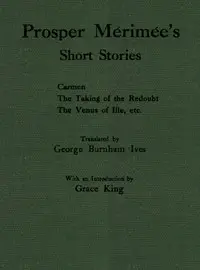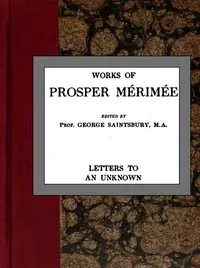"Quatre contes de Prosper Mérimée" by Prosper Mérimée is a collection of short stories, paints portraits of intense human emotions, struggles with right and wrong, and the finer points of culture, all set against beautifully detailed scenes. The book begins with an overview that clues the reader into Mérimée’s story, like his artistic family, schooling, and important connections, that molded his writing style, framing them as reflections of his different interests and the world around him. The book also introduces "Mateo Falcone," a story about a rich Corsican man and his son, focusing on honor and betrayal in a rough, isolated place and the story builds anticipation as his son, Fortunato, wrestles with a tough moral decision about hiding a person on the run, hinting at the intense family drama to come.

Quatre contes de Prosper Mérimée
By Prosper Mérimée
In a world of moral challenges and cultural richness, characters grapple with intense passions and betrayals that will test their very core.
Summary
About the AuthorProsper Mérimée was a French writer in the movement of Romanticism, one of the pioneers of the novella, a short novel or long short story. He was also a noted archaeologist and historian, an important figure in the history of architectural preservation. He is best known for his novella Carmen, which became the basis of Bizet's opera Carmen. He learned Russian, a language for which he had great affection, before translating the work of several notable Russian writers, including Pushkin and Gogol, into French. From 1830 until 1860 he was the inspector of French historical monuments, responsible for the protection of many historic sites, including the medieval citadel of Carcassonne and the restoration of the façade of the cathedral of Notre-Dame de Paris. Along with the writer George Sand, he discovered the series of tapestries called The Lady and the Unicorn, arranging for their preservation. He was instrumental in the creation of Musée national du Moyen Âge in Paris, where the tapestries now are displayed. The official database of French monuments, the Base Mérimée, bears his name.
Prosper Mérimée was a French writer in the movement of Romanticism, one of the pioneers of the novella, a short novel or long short story. He was also a noted archaeologist and historian, an important figure in the history of architectural preservation. He is best known for his novella Carmen, which became the basis of Bizet's opera Carmen. He learned Russian, a language for which he had great affection, before translating the work of several notable Russian writers, including Pushkin and Gogol, into French. From 1830 until 1860 he was the inspector of French historical monuments, responsible for the protection of many historic sites, including the medieval citadel of Carcassonne and the restoration of the façade of the cathedral of Notre-Dame de Paris. Along with the writer George Sand, he discovered the series of tapestries called The Lady and the Unicorn, arranging for their preservation. He was instrumental in the creation of Musée national du Moyen Âge in Paris, where the tapestries now are displayed. The official database of French monuments, the Base Mérimée, bears his name.










